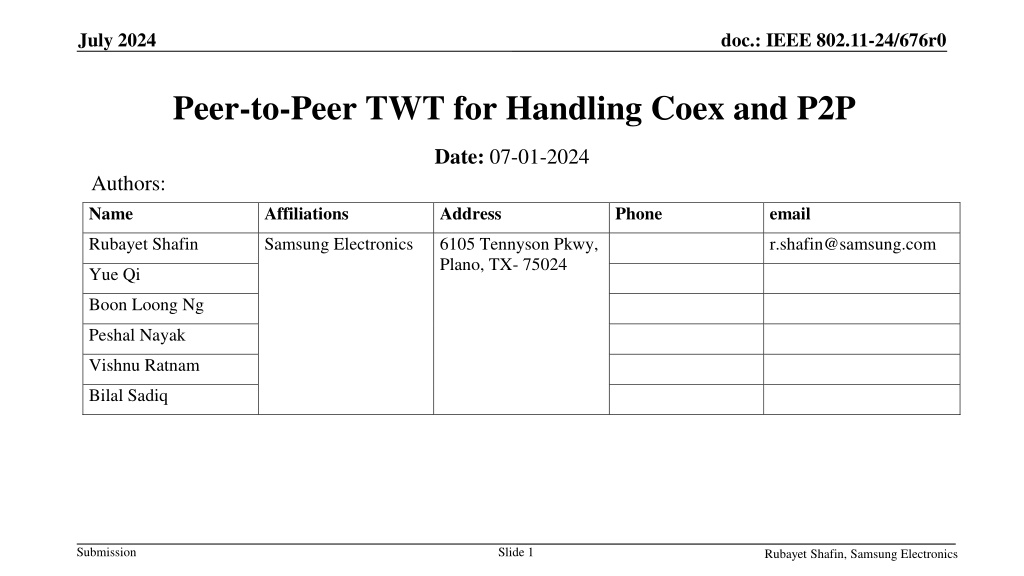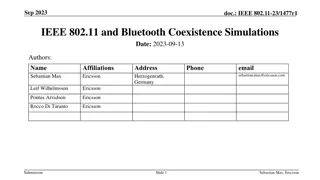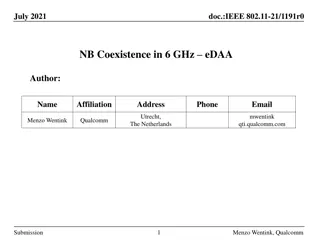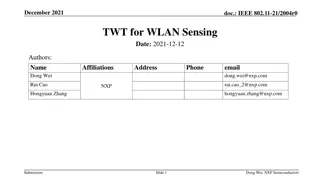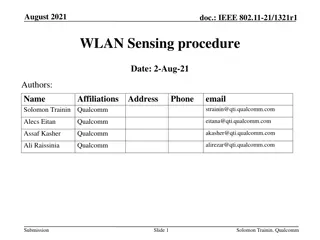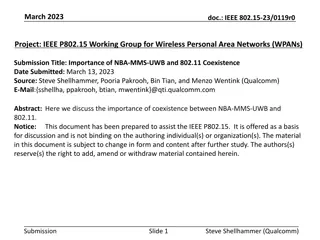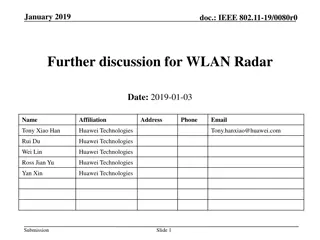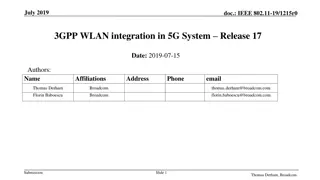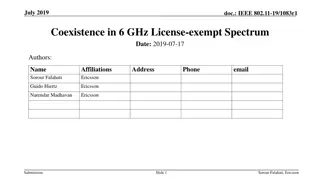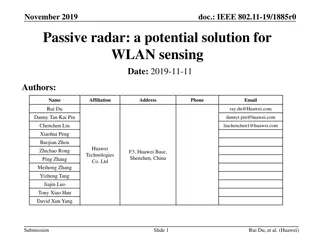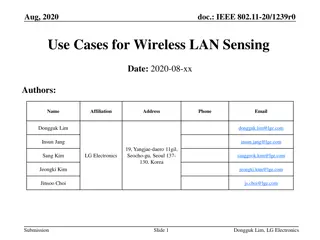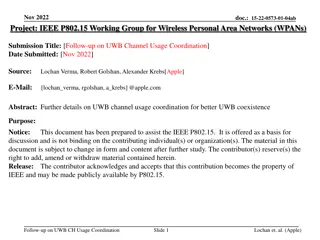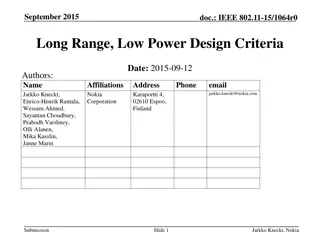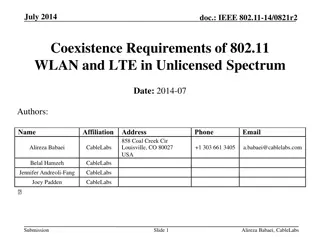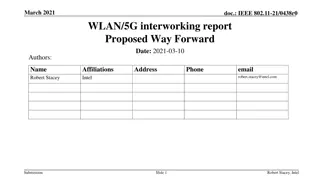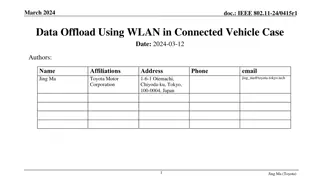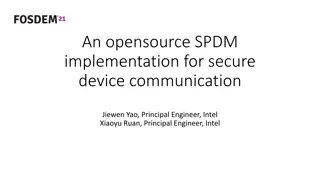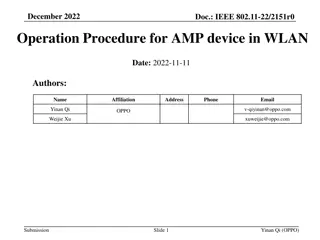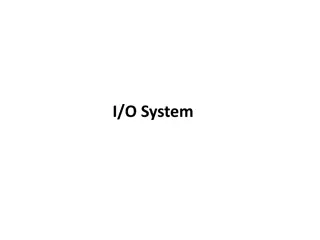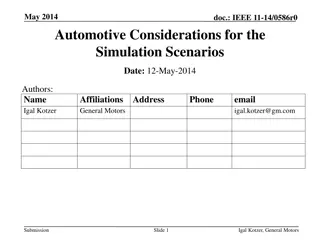Enhancements for In-Device Coexistence in WLAN Devices
This document presents potential enhancements to IEEE 802.11 standards to improve in-device coexistence for WLAN devices. It addresses the challenges of coexistence events caused by interactions with other Wi-Fi and non-Wi-Fi devices, proposing solutions for handling these issues efficiently. The focus is on enhancing performance and reliability for WLAN STAs amidst coexistence scenarios in the network.
Download Presentation

Please find below an Image/Link to download the presentation.
The content on the website is provided AS IS for your information and personal use only. It may not be sold, licensed, or shared on other websites without obtaining consent from the author. Download presentation by click this link. If you encounter any issues during the download, it is possible that the publisher has removed the file from their server.
E N D
Presentation Transcript
July 2024 doc.: IEEE 802.11-24/676r0 Peer-to-Peer TWT for Handling Coex and P2P Date: 07-01-2024 Authors: Name Affiliations Address Phone email Rubayet Shafin Samsung Electronics 6105 Tennyson Pkwy, Plano, TX- 75024 r.shafin@samsung.com Yue Qi Boon Loong Ng Peshal Nayak Vishnu Ratnam Bilal Sadiq Submission Slide 1 Rubayet Shafin, Samsung Electronics
July 2024 doc.: IEEE 802.11-24/676r0 Abstract In this contribution, we provide some of the potential enhancements to 802.11 to better support in-device coexistence for WLAN devices. Submission Slide 2 Rubayet Shafin, Samsung Electronics
July 2024 doc.: IEEE 802.11-24/676r0 Introduction Improving the in-device coexistence (co-ex) for WLAN STAs is important to enhance the performance and reliability of the overall network [1-4]. Co-ex event may occur due to interaction with Other Wi-Fi devices: E.g., peer-to-peer (P2P) communication Non-Wi-Fi devices: E.g., Bluetooth, Ultra-wideband (UWB) During the co-ex event, a STA may not be able to communicate with another STA (/AP) using the agreed- upon parameters. New co-ex constraints can be on-- Period of operation: co-ex event overlapping with existing expected transmissions/reception time Frequency: co-ex event happening on a specific frequency Spatial streams: co-ex event reducing the receive NSS capability Better addressing the in-device coexistence issues should be one of the critical goals for the TGbn group. Submission Slide 3 Rubayet Shafin, Samsung Electronics
July 2024 doc.: IEEE 802.11-24/676r0 Handling In-Device Co-existence Issues In general, for predictable and non-urgent co-ex events, the STA (/AP) can notify the other AP(/STA) ahead of time about the upcoming unavailability for operation Existing technologies defined in 802.11, such as peer-to-peer TWT, can be used or enhanced to support these co-ex events For urgent co-ex events, a TXOP-level intervention is needed The STA(/AP) can indicate within a TXOP the reduced capability of operation due to the co-ex events Control frames can be used to make such indications Truncated TXOP Reduced BW Reduced RX NSS etc. Submission Slide 4 Rubayet Shafin, Samsung Electronics
July 2024 doc.: IEEE 802.11-24/676r0 Background: Peer-to-Peer TWT Peer-to-peer TWT was introduced in the baseline to indicate to the AP the periodic unavailability of the STA due to coex/P2P communication. The baseline channel usage procedure was extended to facilitate peer-to-peer TWT. Instead of TWT Setup frame, the non-AP STA sends a Channel Usage Request frame and include a TWT element to request to set up a peer-to-peer TWT schedule with the AP Once, a peer-to-peer TWT schedule is set up with the non-AP STA, the AP does not send any downlink frame to the non-AP STA and does not solicit uplink frame from the non-AP STA. Unavailability schedule setup Channel Usage Response frame AP1 Channel Usage Request frame (with TWT IE) STA1 Unavailability Unavailability Unavailability Unavailability Submission Slide 5 Rubayet Shafin, Samsung Electronics
July 2024 doc.: IEEE 802.11-24/676r0 Need for Enhancements For TWT operation--due to the lack of granularity in the TWT interval units, once the TWT has been setup, it is expected that there would be a mismatch between traffic arrival time and the TWT SP start time. Also, if the AP has a P2P link, the AP clock and the P2P group s clock may get unsynchronized over time, we may need to re-align the TWT SP start time. For Peer-to-peer TWT, there needs to be a mechanism to update/revise the peer- to-peer TWT SP start time so that it is aligned with the coex/P2P start time Submission Slide 6 Rubayet Shafin, Samsung Electronics
July 2024 doc.: IEEE 802.11-24/676r0 Flexible Peer-to-peer TWT We need a mechanism to flexibly change the subsequent peer-to-peer TWT SP start time Previous agreement between AP1 and STA1 on the unavailability schedule of STA1 (unavailability SPs are shown) Unavailability SP 1 Unavailability SP 2 Unavailability SP 3 Unavailability SP 4 New unavailability schedule of STA1 (unavailability SPs are shown) Indication of change in unavailability SPs starting from the next SP) Unavailability SP 1 Unavailability SP 2 Unavailability SP 3 Unavailability SP 4 Submission Slide 7 Rubayet Shafin, Samsung Electronics
July 2024 doc.: IEEE 802.11-24/676r0 Flexible Peer-to-peer TWT: Example Unavailability schedule Modification Unavailability schedule setup Unavailability Modification Resp. frame Channel Usage Response frame AP1 Unavailability SP based on previous agreement Unavailability Modification Req. frame Channel Usage Request frame (with TWT IE) New Unavailability SP STA1 New Unavailability SP Unavailability Unavailability Shift in schedule (advancing the start time of the SPs) Submission Slide 8 Rubayet Shafin, Samsung Electronics
July 2024 doc.: IEEE 802.11-24/676r0 Summary Peer-to-peer TWT is important for handling coex events For effective unavailability indication using peer-to-peer TWT, it would be essential to devise a mechanism to update the start time of the subsequent SPs in a sequence of peer- to-peer TWT SPs. Submission Slide 9 Rubayet Shafin, Samsung Electronics
July 2024 doc.: IEEE 802.11-24/676r0 References [1] Liwen Chu, et.al., IEEE 802.11-23/1934r0, In-device interference mitigation follow up . [2] Alfred Asterjadhi, et.al., IEEE 802.11-23/1964r0, Coexistence Protocols for UHR . [3] Laurent Cariou, et.al., IEEE 802.11-23/2002r1, In-device coexistence and interference follow up . [4] Brian Hart, et.al., IEEE 802.11-23/2026r0, Balanced In-Device Coexistence . [5] Rubayet Shafin, et.al., IEEE 802.11-24/509r1, Thoughts on in-device coexistence and P2P for 11bn Submission Slide 10 Rubayet Shafin, Samsung Electronics
